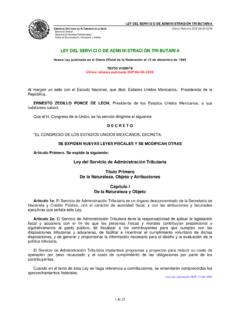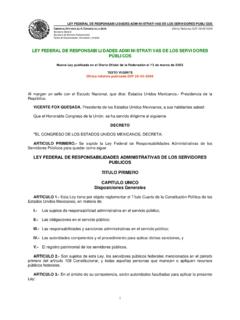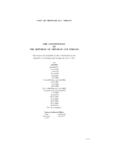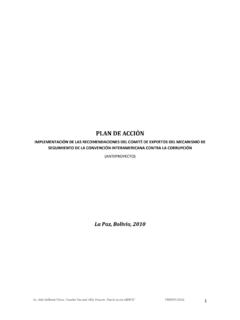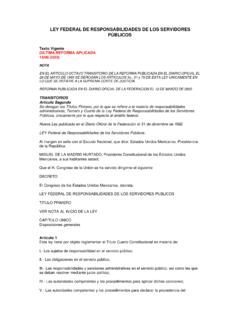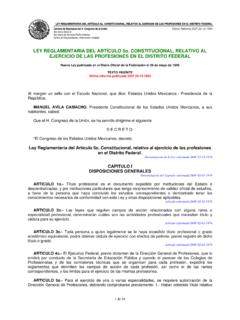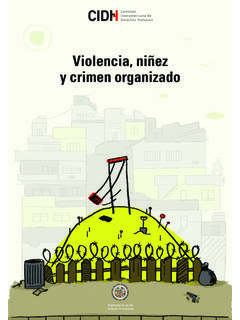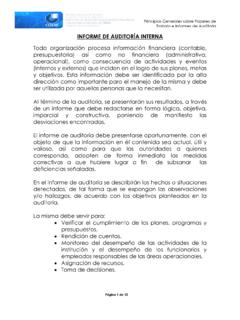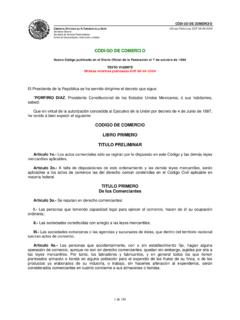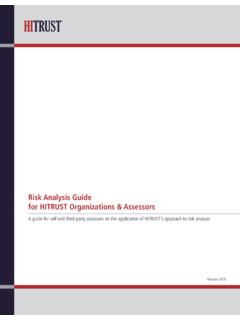Transcription of White paper series Issue 5 - oas.org
1 More rightsfor more peopleWhite paper seriesIssue 52019 FRAMEWORK (CSF)NIST CYBERSECURITYA comprehensive approach to cybersecurityA comprehensive approachto cybersecurityFRAMEWORK (CSF)NIST CYBERSECURITYCREDITSOEA Technical TeamAWS Technical TeamSecretary GeneralOrganization of American States (OAS)Farah Diva Urrutia Alison August Treppel Belisario Contreras Santiago Paz Fabiana Santell n Kerry-Ann Barrett Nathalia Foditsch Diego Subero David Moreno Mariana Cardona Jaime Fuentes Miguel ngel Ca adaAbby Daniell Michael South Andres Maz Melanie KaplanMin HyunLuis History of the CSF CSF Structure Strategy to adopt the Main United Kingdom - An open Uruguay - A guided CSF Functions Versions and mechanisms of evolution Cybersecurity Framework (CSF) to use the CSF?
2 Studies0203070904081005060307091213142 NIST Cybersecurity Framework (CSF) / A comprehensive approach to cybersecurity1. IntroductionGiven a steady increase in the number of cybersecurity incidents in the US, President Barack Obama, on February 12, 2013, issued Executive Order 13636 [1] entrusting the National Institute of Standards and Technologies (NIST) the development of the Cybersecurity Framework for the protection of critical infrastructures, which is now known as the NIST Cybersecurity Framework (CSF). The US identified 16 critical infrastructure sectors: Chemical; Commercial Facilities; Communications; Critical Manufacturing; Dams; Defense Industrial Base; Emergency Services; Energy; Financial Services; Food and Agriculture; Government Facilities; Healthcare and Public Health; Information Technology; Nuclear Reactors, Materials, and Waste; Transportation Systems; and Water and Wastewater Systems.
3 [18]The Framework was conceived as a means to identify the applicable safety standards and guidelines in all sectors of critical infrastructure, providing a flexible and repeatable approach, to allow the prioritization of activities. The aim was also to ensure sustainable performance, while remaining profitable for the is undoubtedly a tool for cybersecurity risk management, which enables technological innovation while adjusting to all types of organizations (regardless of category or size).The Framework strategy was based on industry-accepted standards in the cybersecurity ecosystem (NIST SP 800-53 [2], ISO/IEC 27001:2013[3], COBIT 5[4], CIS CSC[5], among others). They are presented as a simple-approach strategy to cybersecurity governance, to make it possible to easily transfer technical notions to the business objectives and needs.
4 A participatory methodology was used in preparation, where all the interested parties (government, industry, academia) were able to engage and provide s main innovation is the setting aside of rigid standards, which was the norm at that time, but it was not the first to advance an initiative for the protection of critical infrastructures. NATO had already developed a series of manuals aimed at the protection of critical infrastructures for national defense, one being the National Cyber Security Framework Manual [14]. Far from excluding these documents, NIST s CSF complements and improves major difference in the CSF with respect to its predecessors is simplicity and flexibility: simplicity in transmiting a technical strategy in terms readily understandable by the business; and flexibility to adapt to any organization.
5 This difference is what has made the industry and the technical community around the world embrace this framework to date. Companies, academia and governments have voluntarily adopted the CSF as part of their cybersecurity strategy. Even leading organizations in preparing standards and regulations, such as ISACA and ISO, have incorporated the CSF. In particular, ISO produced ISO/IEC TR 27103:2018 [6] that provides guidance on how to take advantage of existing standards in a cybersecurity framework, in other words, how to use the Cybersecurity Framework (CSF) / A comprehensive approach to cybersecurity2. NIST Cybersecurity Framework (CSF) History of the CSF The process of preparing the Framework began in the US with Executive Order No.
6 13636, published on February 12, 2013. This Order introduced efforts to share information on cybersecurity threats and to build a set of current and successful approaches: a framework to reduce risks to critical infrastructure. Under this Executive Order, NIST took charge of the outlining of the Cybersecurity Framework. Some of the development requirements were: to identify the applicable safety standards and guidelines in all critical infrastructure sectors; to provide a priority-based, flexible, repeatable outlook based on performance and profitability; to help identify, evaluate and manage cyber risk; to include guidance on how to measure the performance of Cybersecurity Framework implementation; and to identify areas for improvement that must be addressed through future collaboration with individual sectors and organizations that develop of the FrameworkThe Framework was, and continues to be, developed and promoted through continued engagement and input from government, industry and academia stakeholders.
7 To develop the Framework, in the course of a year, NIST used a Request for Information (RFI) and a Request for Comments (RFC), as well as ample dissemination and workshops throughout the US to: (i) identify existing cybersecurity standards, guidelines, frameworks and best practices applicable to increase the security of the critical infrastructure sectors and other interested entities; (ii) specify high priority gaps which needed new or revised standards; and (iii) develop collaborative action plans to address these updating the CSF to version , which was published in April 2018, NIST continued with its participatory strategy, welcoming experts and industry, as well as governments and non-US companies. For example, participating entities included the government of Israel and Huawei Technologies.
8 [17]4 NIST Cybersecurity Framework (CSF) / A comprehensive approach to CSF StructureThe NIST Cybersecurity Framework (CSF) consists of three main components: Core Implementation Tiers ProfilesFramework CoreThe Core is a set of desired cybersecurity activities and outcomes, organized into Categories and aligned to Informational References to industry-accepted standards. It is designed to be intuitive and to act as a translation layer to enable communication between multi-disciplinary teams by usin simplistic and non-technical language. The Core consists of three parts: Functions, Categories and Subcategories. It includes five high-level functions: Identify, Protect, Detect, Respond and Recover. The next level down is the 23 categories, which are split across the five Functions.
9 They were designed to cover the breadth of cybersecurity objectives for an organization, without being too detailed, covering issues related to technical aspects, people and processes, with a focus on Subcategories are the deepest levels in the Core. There are 108 Subcategories, which are outcome-driven statements that provide considerations for creating or improving a cybersecurity program. Because the Framework is outcome-driven and does not mandate how an organization should achieve those results, it enables risk-based implementations that are customized to the needs of different Implementation TiersTiers describe the degree to which an organization s cybersecurity risk management practices exhibit the characteristics defined in the Framework. The Tiers range from Partial (Tier 1) to Adaptive (Level 4) and describe an increasing degree of rigor, and how well integrated cybersecurity risk decisions are into broader risk decisions, and the degree to which organization shares and receives cybersecurity information from external parties.
10 TIER 1 PartialTIER 2 RiskInformedTIER 3 RepeatableTIER 4 AdaptiveRisk Management ProcessIntegrated Risk Management ProgramExternal Participation5 NIST Cybersecurity Framework (CSF) / A comprehensive approach to CSF FunctionsAlthough NIST points out that the Tiers do not necessarily represent levels of maturity, in practice they do resemble that. What is important is that organizations should determine the desired Tier (not all controls must be implemented at the highest Tier), making sure that the selected level meets at least the organization s goals, reduces cybersecurity risk to acceptable levels, has an acceptable cost and is feasible to implement. Framework ProfilesThe profiles are the unique alignment of an organization s organizational requirements and objectives, the risk appetite and the resources against the desired outcomes of the Core Framework.
